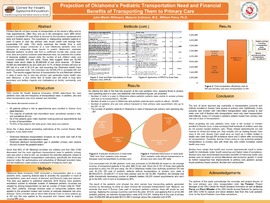| dc.contributor.author | Willmann, John-Martin | |
| dc.contributor.author | Erdmann, Marjorie | |
| dc.contributor.author | Paiva, William | |
| dc.date.accessioned | 2020-04-14T16:12:38Z | |
| dc.date.available | 2020-04-14T16:12:38Z | |
| dc.date.issued | 2019-02-22 | |
| dc.identifier | ouhd_willmann_projectionof_2019 | |
| dc.identifier.citation | Willmann, J.-M., Erdmann, M., & Paiva, W. (2019, Feb. 22). Projection of Oklahoma's pediatric transportation need and financial benefits of transporting them to primary care. Poster presented on Research Day at the Oklahoma State University Center for Health Sciences, Tulsa, OK. | |
| dc.identifier.uri | https://hdl.handle.net/11244/323874 | |
| dc.description.abstract | Children that do not have access or transportation to the doctor's office tend to miss appointments. Often they end up in the emergency room (ER) which results in avoidable ER cost which is incurred by the insurance companies and state and federal payers. The hypothesis is: transporting pediatric patients in need of same or next day primary care would create cost savings from preventable ER visits. This study examines the results from a pilot transportation project conducted at a rural Oklahoma pediatric clinic and attempts to extrapolate these results to predict Oklahoma's statewide Medicaid pediatric no-show rate from a confirmed no-ride rate. Using rural clinic data and publicly available state Medicaid data, we predicted the number of statewide pediatric missed visits, the number of sick children visits, and incurred avoidable ER visit costs. These data suggest there are 52,386 missed visits which totals to $5,066,808 of lost clinic revenue. Of these, 36,908 are estimated to be sick visits and 16.7% of these children will incur an ER visit at a cost of $1,316 per visit according the Oklahoma Health Care Authority published data. This translates into $8,095,279 in avoidable ER visit costs. The results suggest the lack of transportation for sick Medicaid children in need of same day or next day primary care generates higher health care cost. Moreover, a sick child's lack of health care will result in long term secondary and tertiary impacts and implications on family, community, and state. | |
| dc.format | application/pdf | |
| dc.language | en_US | |
| dc.publisher | Oklahoma State University Center for Health Sciences | |
| dc.rights | The author(s) retain the copyright or have the right to deposit the item giving the Oklahoma State University Library a limited, non-exclusive right to share this material in its institutional repository. Contact Digital Resources and Discovery Services at lib-dls@okstate.edu or 405-744-9161 for the permission policy on the use, reproduction or distribution of this material. | |
| dc.title | Projection of Oklahoma's pediatric transportation need and financial benefits of transporting them to primary care | |
| osu.filename | ouhd_willmann_projectionof_2019.pdf | |
| dc.type.genre | Presentation | |
| dc.type.material | Text | |
